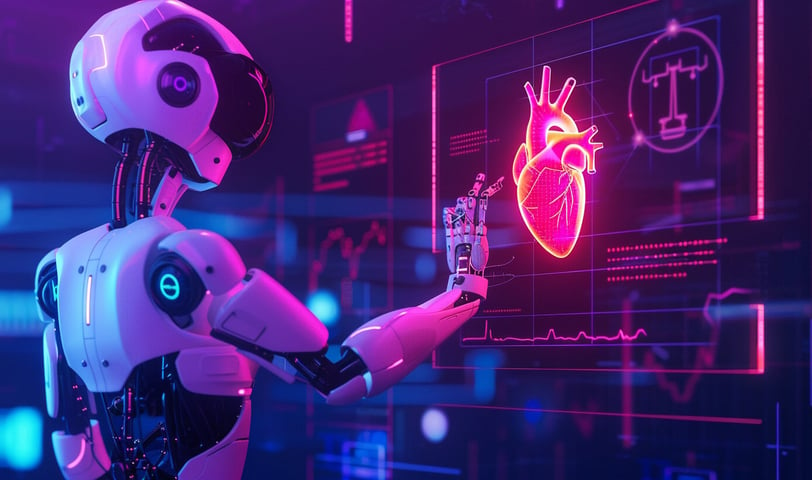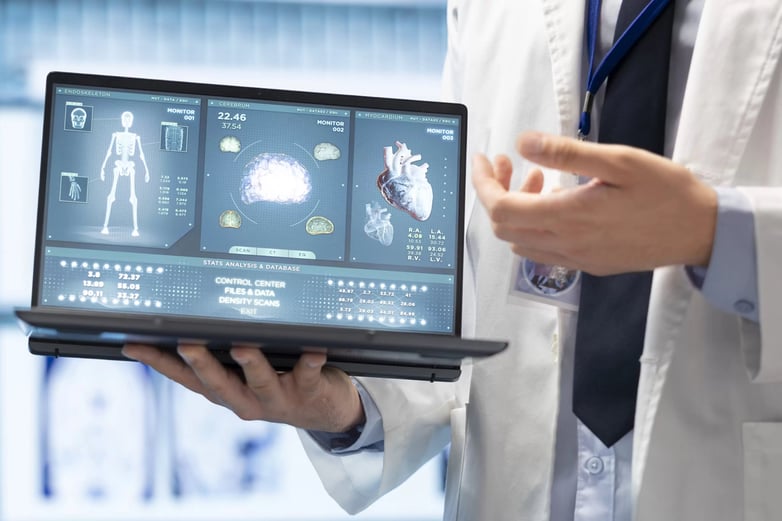AI-Powered X-ray: How Deep Learning is Improving Diagnostic Accuracy
The healthcare industry has seen remarkable advancements over the past few decades, but one area that is experiencing a rapid transformation is medical imaging. Among the cutting-edge technologies that are redefining diagnostic procedures is Artificial Intelligence (AI), particularly Deep Learning. In recent years, AI-powered X-ray systems have emerged as powerful tools that assist healthcare professionals in making faster, more accurate diagnoses. But what exactly is deep learning, and how is it enhancing the diagnostic power of X-ray technology? Let’s explore.
2/24/20255 min read


What is Deep Learning?
Deep Learning is a subdivision of Artificial Intelligence (AI) that replicates the process of learning through experience in human beings. After using neural networks that have been specifically programmed to model the architecture of the human brain, deep learning systems can review vast collections of data, make connections, and forecast results without being programmed specifically to perform every task.
Deep learning models learn to see and read complex X-ray images, detect disease and abnormality. Deep learning models are trained on vast datasets of labeled X-ray images, and thus are able to detect patterns that human radiologists cannot see or miss altogether.
How Deep Learning is Enhancing X-ray Imaging
Improved Accuracy and Early Detection of Diseases
The ability of deep learning models to be trained on profoundly large sets of X-rays allows them to detect elegantly subtle abnormalities and patterns that the human eye cannot detect. They are trained to recognize infinitesimal variations in tissue structure, density, and other characteristics that can be symptomatic of conditions such as lung cancer, pneumonia, fractures, and tuberculosis.
For instance, computer vision is able to read chest X-rays independently and identify the first sign of lung cancer, a condition that would be hard to diagnose if it is still in its early stage. AI deep learning algorithms are assisting physicians in identifying diseases when they are in their early stage, which can be treated.
Automated Image Interpretation
One of the largest problems that radiologists have is the amount of X-rays that they must read. In extremely busy clinics or hospitals, there are a number of images to be read per day, and it becomes tired and prone to making mistakes. It can render radiologists obsolete and notify them of abnormal findings using deep learning algorithms.
For example, deep models can quickly scan for signs of pneumonia or fractures on a chest X-ray and highlight areas that should be explored. Not only does this save valuable time but also the likelihood of human error so something important falls through the cracks.
Moreover, AI computers are also learners. From experience gained through increased information and new medical information, the computer programs become more accurate and with each passing day enhance the diagnosis.
Faster Diagnosis and Reduced Workload for Radiologists
In traditional medical imaging, the radiologists must examine each image separately, and it would take hours or minutes depending on the case. AI technology, on the other hand, can analyze X-ray images in seconds. Such huge time saving can even transform the whole diagnostic process, especially in emergency cases where time is of the essence.
By automatically analyzing images for radiologists, deep learning solutions release them from the workload to concentrate on problematic cases where their skills are most beneficial. Not only does this boost the overall productivity of the diagnostic process, but it allows hospitals to read more patients in shorter periods.
Consistency and Reliability
Human interpretation of X-ray images may be fatigued, biased, or inconsistent at times. Deep learning models, however, can decipher images with high accuracy and consistency. Machine learning models once trained utilize the same parameters to assess all images, making results objective and precise.
For example, deep learning technology can scan X-rays for infection or crack daily without endangering missing life-critical abnormalities due to distraction or human error. Repetition enhances the quality of patient outcomes and care.
Improved Access to Healthcare
X-ray machines using AI can also serve to make access to more medical care possible through the delivery of diagnosis services in distant or underdeveloped areas where access to radiologists could be inconvenient. Remote X-rays can be shipped by medical personnel to cloud servers, and deep learning algorithms will then analyze images and provide instant feedback.
This will provide telemedicine or distant healthcare providers with access to make speedy diagnoses without even achieving referral access to specialty radiologists. Access to such quick and quality X-ray analysis through the services of AI would greatly increase the degree of healthcare access, especially in the developing world.
Applications of Deep Learning in X-ray Imaging
Deep learning algorithms are already being used in several areas of medical imaging, including:
Lung Disease Detection: Medical imaging is being exposed to various various deep learning models in various applications.
Bone Fracture Detection: Deep learning algorithms are excellent at identifying fractures and other bone abnormalities in X-rays, improving diagnosis and treatment plans for bone injuries.
Cardiovascular Conditions: AI can be used for heart X-ray scan, identification of initial signs of cardiovascular disease, i.e., aortic aneurysm or heart failure.
Orthopedic Imaging: Orthopedic musculoskeletal X-rays can be identified by AI software for identification of conditions like joint dislocation, arthritis, and spinal deformity.
Abdominal Imaging:Abdominal X-rays can be analyzed with the assistance of deep learning in identifying organ abnormality, gastrointestinal disease, or infection.
The Challenges of AI in Medical Imaging
While AI and deep learning have transformed medical imaging, there are some challenges to be addressed:
Data Privacy and Security: The AI solutions rely on large databases of patient images to train the algorithms. Patient data security and privacy are necessary to establish trust, as well as adherence to regulations like HIPAA (Health Insurance Portability and Accountability Act).
Bias in Algorithms: Deep learning algorithms are only as good as the dataset on which they have been trained. If a data set has been biased or is non-representative in nature, the AI system can potentially generate false and discriminatory results. There must be some mechanism by which representative and diverse datasets are employed in training AI models with a conscious effort not to fall into such traps.
Regulatory Approval: Healthcare AI products must undergo stringent testing and regulatory approval before they can be applied to healthcare. The AI technology must satisfy the requirements of safety and efficacy such that it can enable universal application.
Human-AI Collaboration: AI is not meant to replace radiologists or other healthcare professionals; instead, it is designed to assist them. The key to successful implementation of AI-powered X-ray systems is ensuring a smooth collaboration between AI tools and human experts. Radiologists must be able to trust and understand the AI’s findings while making the final decisions based on their professional judgment.
The Future of AI-Powered X-ray Technology
As AI and deep learning technologies continue to evolve, the future of medical imaging looks incredibly promising. With ongoing advancements in AI algorithms, we can expect even more precise and reliable diagnostic tools, offering faster and more accurate results for a wider range of diseases and conditions. Additionally, AI-powered X-ray systems will likely become more integrated into everyday clinical workflows, improving the efficiency of healthcare delivery and ensuring better patient outcomes.


Reference Website Link:
Diagnostic accuracy of deep learning in medical imaging
Validation of a Deep Learning Chest X-ray Interpretation Model
AI-Driven Thoracic X-ray Diagnostics: Transformative Transfer Learning Approaches
Diagnostic accuracy of a commercially available deep-learning model for the diagnosis of pneumothorax on chest radiographs
https://academic.oup.com/bjr/article/95/1134/20210979/7451439?
Can Deep Learning Reliably Recognize Abnormality Patterns on Chest X-rays? A Multi-Reader Study Examining One Month of AI Implementation in Everyday Radiology Clinical Practice
Innovative
Contact Us
Service
xraybazar.com
© 2024. All rights reserved.
Address- Rajasthan, India
Gmail Id- xraybazaroffcial.com
Important Links
